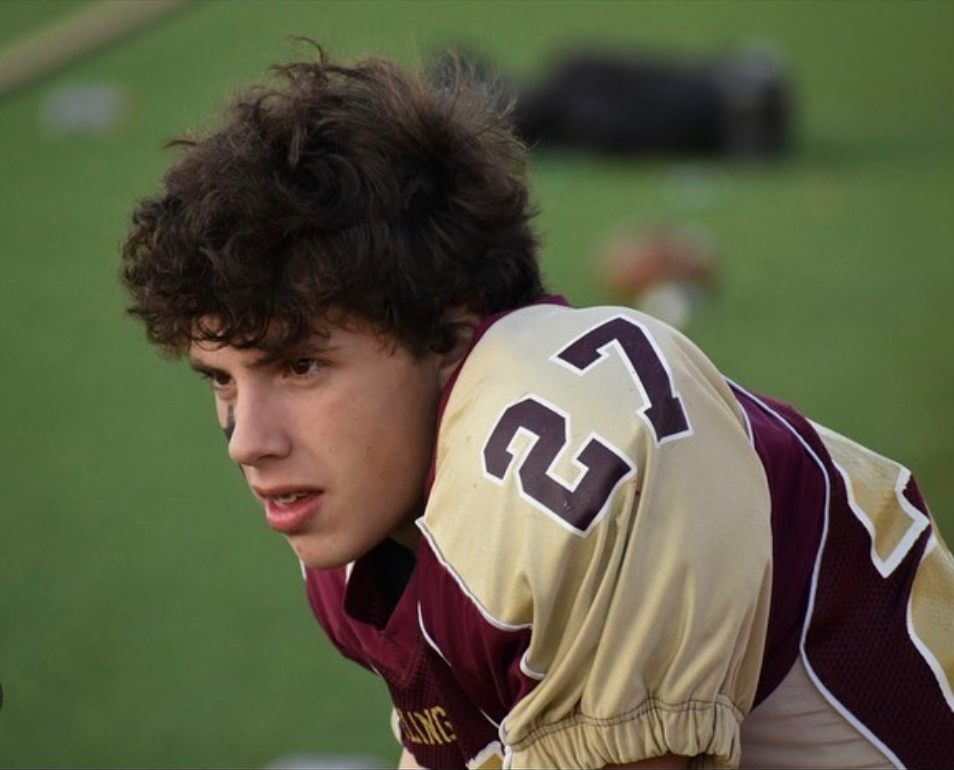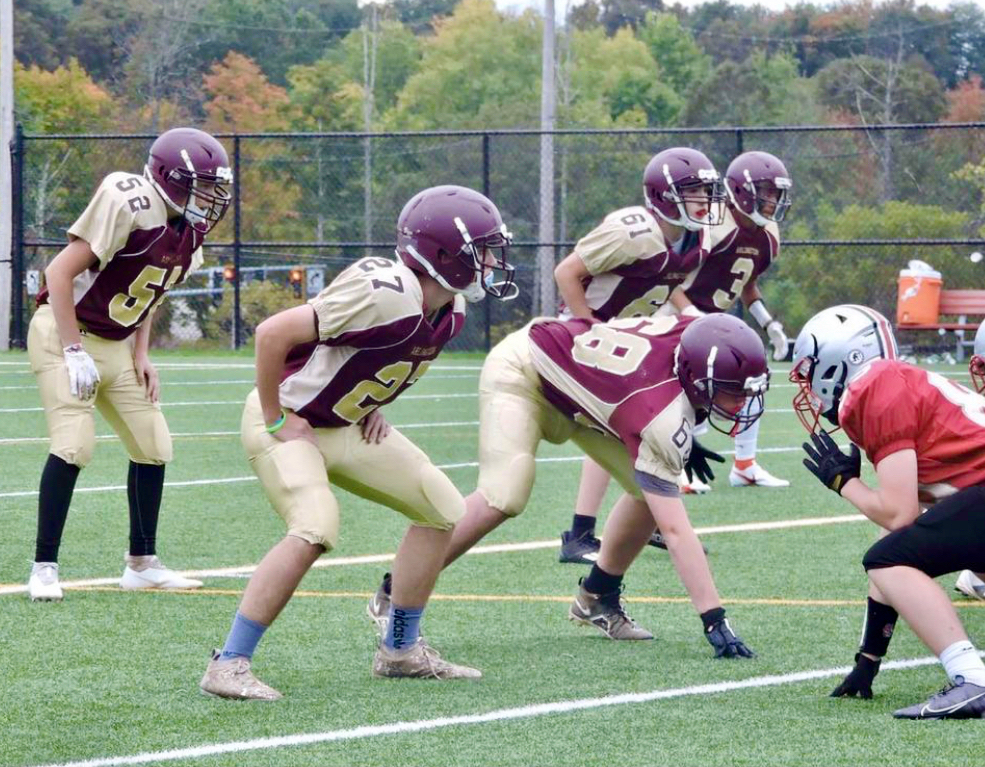Fantasy (Nightmare) Football
News Based on facts, either observed and verified directly by the reporter, or reported and verified from knowledgeable sources.
Supporting our teenage son’s interest in playing America’s beloved contact sport while coping with our worst fears about it.

Good morning! Today is Monday, November 22, and you are reading today’s section of Examiner+, a digital newsmagazine serving Westchester, Putnam, and the surrounding Hudson Valley.
Need to subscribe — or upgrade your Examiner+ subscription to enjoy full access to all of our premium digital content? Details here.
By Brian Howard

Howard’s son, Kevin, donning pads for the first time as a freshman high school football player.
From 2006 to 2019, the number of football players on public high school teams in the state fell by more than 17,000, or 28 percent, according to survey figures published by the New York Public High School Athletic Association.
Meanwhile, in the 2021-22 school year, the number of high school football players living in my house increased by one.
There are a number of possible reasons why high school football would be on the decline even as the NFL remains the most popular and profitable league in all of sports.
For one thing, schools offer kids a dizzying menu of alternatives these days — jazz band, tai chi club, girls and boys fencing, anyone? Then there’s gaming, which any parent can tell you can leave little time for much else.
For my wife and me, though, it was the potential for concussions and other injuries that made us determined to keep our son off the gridiron. Instead, Kevin has played baseball, soccer, and basketball. He spent years earning a rainbow of belts in taekwondo. He even went out for the track team in middle school.
Do a Google search for terms like “football and concussions” or “dangerous high school sports” and you’ll see some sobering links to various studies that rank football up there with hockey and girls soccer as the top sports to avoid for the injury-averse. On the other hand, the National Federation of State High School Associations, which advocates for high school athletics, makes extensive safety resources for football and other sports available online to schools and programs.
We weren’t the only parents among his circle of friends who took football off the table. Still, it turns out kids are pretty smart, and they’re not incapable of working together. In other words, our kids ganged up on us.
Separately but in coordinated fashion they came to us and asked to play football this fall. “Everyone is playing,” they said, about which I’d wonder, “Even so-and-so? No way his mom is letting that happen.” Meanwhile, at so-and-so’s house, the dinner table conversation was about how we were the ones who had caved and poor so-and-so would be the only member of the crew not going out for the team.
By the time we adults could compare notes, a half-dozen of our sons were signed up for training camp. Most had never donned pads before.
I was all in, though. I tend to live vicariously through my son’s accomplishments, which unfailingly exceed my own at the same age. My wife was on board too. Despite her fears, she stocked up on fan apparel, arranged carpools to and from practices, and took it as a given we wouldn’t miss a game.
So for the past four months, we’ve been a football family, with all the stinky, sweat-soaked gear, long waits for pickups from practices, and insistently cheery post-game banter after more experienced squads showed the boys how the game is played. The most remarkable thing is how much he loves it, possibly more than any other sport he’s played. The teamwork, the camaraderie, and the chance to learn new skills are partly why.
He’ll also tell you he loves hitting people and getting hit. That’s my boy.
Practice is almost daily, while the games have been few. Scheduling issues and an opposing team’s COVID outbreak have held the team to just four games at this writing. That said, football seemed to be working out. Maybe our fears of injury were overblown after all.
What were we thinking? Isn’t this what we worried about?
Then came the texts as I was racing north on the Taconic Parkway last Thursday. I work an hour away and expected to miss most of the first half. Game time was 4:30, and my wife’s message from the stands at 4:28 said that the visiting team had already scored.

Then she texted again. “He got hurt. I think his ankle or calf. They took him out.” I cringed but stayed positive. He’ll walk it off, miss a few plays, and go back in. When I got there, though, he was on the bench, icing his leg. After a while, he got up and limped to the sideline right by the coach. Good man, I thought, show him how tough you are. But then he turned and walked back to the bench and stayed there the rest of the game. When he came off the field, you could see it in his eyes. He was hurting. He’d collided with a teammate on a play that was captured on game film and later shared by his teammates.
I’ve seen plenty of NFL players go down and stay down a few beats too long for comfort. It is another thing when it’s your kid down on the turf. Second thoughts raced through my head as I drove to urgent care and waited forever for the one doctor on duty to order and read the X-rays. What were we thinking? Isn’t this what we worried about?
Well, no. We worried about concussions because those make headlines. Collision injuries happen in every sport, including baseball, which he has played the most. The way he runs the basepaths, he should have airbags. The one time he ever got hurt on the diamond was in a game he wasn’t supposed to play. He got hurt twice that day, actually. I’ll never shake the memory of him in left field, turning around because someone yelled “Ball!” just as a foul ball from a nearby field came down and hit him square in the chest. He was wearing his chest protector, and after a few minutes, he got up and stayed in the game. An inning or so later he found himself sliding — safely, mind you — into third, where the throw from the catcher skipped and hit him in the face. He came out, but a short while later he went back in.
This time was different, though. This was a football injury. I was sure the diagnosis would be a hairline fracture. The winter sports season and fall baseball playoffs would be wiped out, along with the last three weeks of football. That explained the look in his eyes when he first came off the field. He didn’t want to miss out. The pain had been secondary. I felt for him. You hate to see your kid hurting, physically or emotionally.
Thankfully, though, it was just a bone bruise. Two days later he made a clutch catch late in a tight travel baseball playoff win. Four days later he was back at football practice. To look at him, you’d think nothing happened. To look at me you’d swear my hair was grayer than it was a week ago. Either way, the season is winding down. If a bruise and some bench time are the worst that happens, it’ll have been a success. We’ll also get a nine-month reprieve until his sophomore season comes around. Until then we can look forward to safer pursuits, where injury isn’t such a major concern.
His friend has him thinking about wrestling. What could go wrong?
Brian Howard works in school communications for Southern Westchester BOCES. He lives in Hopewell Junction with his wife and two children. Fortunately for his alma mater, he did not play high school football.
We hope you’ve enjoyed today’s section of Examiner+. We love honest feedback. Tell us what you think: examinerplus@theexaminernews.com

Examiner Media – Keeping you informed with professionally-reported local news, features, and sports coverage.
